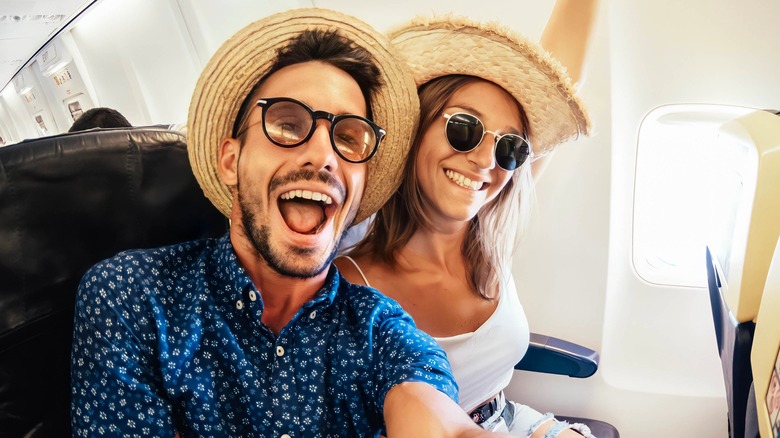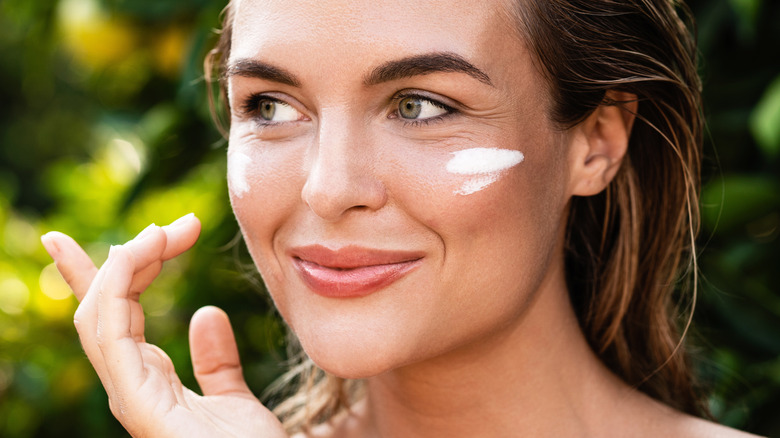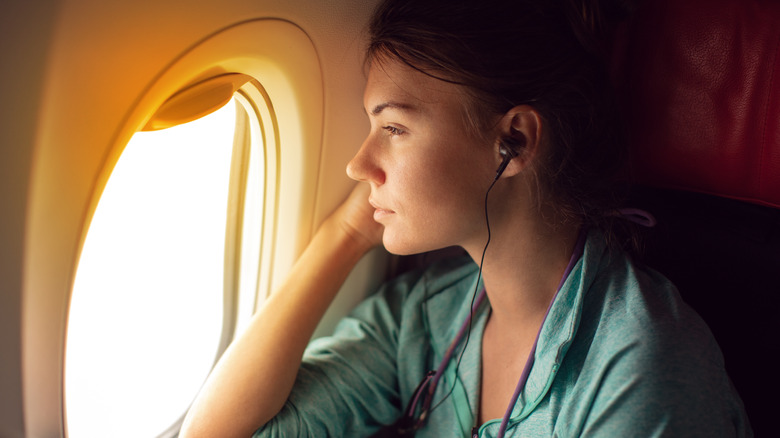You Need More SPF Than Usual If You're On A Flight - Here's Why
Air travel can sometimes feel like a chore. With requirements for TSA-friendly items and limited legroom in sardine-packed spaces, every square inch in our carry-on luggage is beyond priceless. That's why when we pack them — we do our best to squeeze in only the things that we can't survive without at cruising altitudes. This might be a book to keep boredom at bay, a travel pillow to make airborne naps less unbearable, or medication and basic toiletries to keep us comfortable. Sunscreen is important, but it rarely makes our list of carry-on must-haves.
Many of us keep skincare products in checked baggage and slather on all the SPF we need before hitting the airport. The reason is that liquid sunscreens are not the most TSA-friendly items in terms of ounce rule, and it doesn't seem necessary to reapply SPF when you're traveling in a compressed aircraft. While it's true that there's a limit to the size of your carry-on sunscreen, it's wrong to think that you don't need SPF when you're sitting in an airplane. Commercial airplane windows might be resistant to bird strikes, but they are a long way from outsmarting the sun. Indeed, you need more SPF than usual if you're on a flight.
UV radiation becomes more damaging when altitude increases
You should never underestimate the penetration depth of ultraviolet (UV) rays. UV-A radiation, which makes up about 95% of sunlight, can pass through glass to penetrate your skin on a deep level, according to MD Anderson. The penetration can trigger oxidative stress in your body and break down collagen and elastin. This can cause a variety of skin disorders, premature aging, and skin cancer.
A 2014 study published in The JAMA Network Journals suggested that, because airplane windshields are not capable of blocking all UV-A radiation, airline pilots may be exposed to the same amount of UV rays as that from a tanning bed session. The authors of the study also recommended pilots and cabin crews always wear sunscreen while in the air and see a dermatologist on a regular basis.
The altitude also poses a threat to the skin. Since there are fewer gas molecules in the air as you ascend, the air becomes less dense and UV radiation levels increaseas well. "The atmosphere helps to scatter damaging UV rays, so the thinner the atmosphere, this protection dwindles and the UV rays are more powerful and damaging," facial plastic and reconstructive surgeon Dr. Jaimie DeRosa told Newsweek.
Whether you're a frequent flyer or not, it's never redundant to take measures to protect your skin from sun damage.
Always wear sunscreen before and during a flight
"Pilots are at higher risk of skin cancer and sun-induced damage as they sit in bright light," dermatologist Dr. Sweta Rai of the British Association of Dermatologists told Sun Online Travel. "But passengers on flights should take heed and do the same. The window next to you on a plane may be small, but you're closer to the ozone layer on a flight by tens of thousands of feet. The sun's rays are much more harmful at this level and we should all be wearing sunscreen when flying."
Even if you don't travel by airplane regularly or your flight is a short haul, do not skimp on a broad-spectrum sunscreen with an SPF of at least 30. Apply it before your flight and reapply it every two hours while you're in the air. You can pack stick sunscreen in your carry-on for easy reapplication. To minimize UV exposure, try to keep the window shut.
When you're 30,000 feet from the ground, UV rays are not the only enemy your skin has to handle. The cabin air — half of which is added from an external source — is relatively low in humidity and drying to your skin, per the Cleveland Clinic. It's not uncommon for people to experience acne breakouts and flaky skin post-flight. To minimize irritations, apply moisturizer pre-departure and reapply it during the flight.


